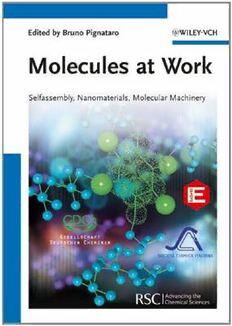
Molecules at Work: Selfassembly, Nanomaterials, Molecular Machinery PDF
Preview Molecules at Work: Selfassembly, Nanomaterials, Molecular Machinery
Editedby BrunoPignataro MoleculesatWork RelatedTitles Pignataro,Bruno(ed.) Pignataro,Bruno(ed.) NewStrategies in Chemical IdeasinChemistryand Synthesis andCatalysis Molecular Sciences WhereChemistryMeetsLife 2012 ISBN:978-3-527-33090-4 2010 ISBN:978-3-527-32541-2 Garcia-Martinez,Javier/ Serrano-Torregrosa,Elena(eds.) Pignataro,Bruno(ed.) TheChemicalElement IdeasinChemistryand Chemistry’sContributiontoOurGlobal Molecular Sciences Future AdvancesinNanotechnology,Materials andDevices 2011 ISBN:978-3-527-32880-2 2010 ISBN:978-3-527-32543-6 Pignataro,Bruno(ed.) IdeasinChemistryand Molecular Sciences AdvancesinSyntheticChemistry 2010 ISBN:978-3-527-32539-9 Edited by Bruno Pignataro Molecules at Work Selfassembly, Nanomaterials, Molecular Machinery TheEditor AllbookspublishedbyWiley-VCHare carefullyproduced.Nevertheless,authors, Prof.BrunoPignataro editors,andpublisherdonotwarrantthe Universita` diPalermo informationcontainedinthesebooks, DipartimentodiChimica includingthisbook,tobefreeoferrors. ‘‘S.Cannizzaro’’ Readersareadvisedtokeepinmindthat VialedelleScienzeed.17 statements,data,illustrations,procedural 90128Palermo detailsorotheritemsmayinadvertentlybe Italy inaccurate. LibraryofCongressCardNo.:appliedfor BritishLibraryCataloguing-in-Publication Data Acataloguerecordforthisbookisavailable fromtheBritishLibrary. Bibliographicinformationpublishedby theDeutscheNationalbibliothek TheDeutscheNationalbibliothek liststhispublicationintheDeutsche Nationalbibliografie;detailedbibliographic dataareavailableontheInternetat <http://dnb.d-nb.de>. 2012Wiley-VCHVerlagGmbH&Co. KGaA,Boschstr.12,Weinheim Allrightsreserved(includingthoseof translationintootherlanguages).Nopart ofthisbookmaybereproducedinany form–byphotoprinting,microfilm,orany othermeans–nortransmittedortranslated intoamachinelanguagewithoutwritten permissionfromthepublishers.Registered names,trademarks,etc.usedinthisbook, evenwhennotspecificallymarkedassuch, arenottobeconsideredunprotectedbylaw. CoverDesign AdamDesign,Weinheim Typesetting LaserwordsPrivateLimited, Chennai,India PrintingandBinding MarkonoPrint MediaPteLtd,Singapore PrintedinSingapore Printedonacid-freepaper PrintISBN:978-3-527-33093-5 ePDFISBN:978-3-527-64581-7 oBookISBN:978-3-527-64578-7 ePubISBN:978-3-527-64580-0 MobiSBN:978-3-527-64579-4 V Contents Preface XIII ListofContributors XXI PartI SelfAssembly 1 1 Yoctoliter-SizedVesselsasPotentialBiologicalModels 3 SheshanathV.Bhosale,BradleyE.Wilman,andStevenJ.Langford 1.1 Introduction 3 1.2 CavitiesonGlassPlatesandGoldSurfaces 5 1.3 PreparationandConfirmationofRigidYoctowellCavity 6 1.3.1 ConfirmationofRigidGaps 7 1.4 MolecularSorting 7 1.5 Yoctowell-BasedMolecularRecognitionEvents 9 1.6 Conclusion 11 Acknowledgments 12 References 12 2 SwitchableHost–GuestInteractionsofSupramolecularRings andCages 13 GuidoH.Clever 2.1 Introduction 13 2.2 Host–GuestChemistry 15 2.3 SwitchinginSupramolecularSystems 17 2.4 NaturalParagons 19 2.5 TypesofExternalInputandMethodsforAnalysis 20 2.5.1 SwitchableHostCompounds 21 2.5.2 SwitchableGuestCompounds 26 2.6 Conclusion 33 References 34 VI Contents PartII NanoMaterials 39 3 TailoredGraphene-TypeMoleculesbyChemicalSynthesis 41 MilanKivalaandXinliangFeng 3.1 Introduction 41 3.2 SyntheticConceptstowardExpandedPAHs – Nanographenes 43 3.2.1 Hexabenzocoronenes(HBCs)andRelatedSystems 43 3.2.2 LargePAHs 48 3.2.3 GrapheneNanoribbons 55 3.2.4 Heteroatom-ContainingPAHs 60 3.3 ConclusionandOutlook 64 References 66 4 AnalyzingtheSurfaceAreaPropertiesofMicroporousMaterials 71 AbbieTrewin 4.1 Introduction 71 4.1.1 Energy 71 4.1.2 H Storage 71 2 4.1.3 CO CaptureandSequestration 72 2 4.1.4 GasSeparation 73 4.2 MicroporousMaterials 74 4.2.1 FrameworkMaterials 74 4.2.2 NetworkMaterials 74 4.2.3 MolecularMaterials 76 4.2.4 StructuralFlexibility 79 4.3 Porosity 81 4.3.1 WhatIsPorosity? 81 4.3.2 IntrinsicversusExtrinsicPorosity 81 4.3.3 MeasuringPorosity 82 4.3.4 CalculatedSurfaceAreasandSimulatedGasUptakes 83 4.3.5 Gas-DiffusionMechanisms 84 4.4 PorousMaterialsandCalculatingSurfaceAreas 85 4.4.1 FrameworkMaterials 85 4.4.2 NetworkMaterials 86 4.4.3 MolecularMaterials 88 4.4.4 MolecularSolidswithSomeExtrinsicPorosity 89 4.4.5 MolecularSolidswithIntrinsicPorosity 90 4.5 Summary 92 Acknowledgments 92 References 93 5 NanostructuredMaterialsBasedonCore-SubstitutedNaphthalene Diimides 97 SheshanathV.Bhosale,BradleyE.Wilman,andStevenJ.Langford 5.1 Introduction 97 Contents VII 5.2 SynthesisofNovelcNDIDerivatives 99 5.3 ElectronTransfer 102 5.4 SupramolecularSelf-AssemblyofcNDI 105 5.5 Conclusion 110 Acknowledgments 110 References 110 6 MetalPhosphides:FromChemist’sOdditiestoDesignedFunctional Materials 113 SophieCarenco,MatthieuDemange,Ce´dricBoissi`ere,Cle´mentSanchez, andNicolasMe´zailles 6.1 Introduction 113 6.2 BulkMetalPhosphides:ALongHistory 113 6.2.1 ANewFamilyofSyntheticInorganicMaterials 113 6.2.2 FirstSetofApplications 114 6.2.3 BulkMetalPhosphidesandToday’sApplications 114 6.3 WhitePhosphorusfortheLow-TemperatureSynthesisofMetal PhosphideNanoparticles 115 6.3.1 WhitePhosphorusasaLow-TemperatureReagent 115 6.3.2 Aryl-andAlkyl-Phosphinesas‘‘P’’AtomDonorinHarshConditions fortheSynthesisofMetalPhosphideNanoparticles 115 6.3.3 NickelPhosphideNanoparticlesfromP inStoichiometricandMild 4 Conditions 116 6.3.4 GeneralizationoftheWhitePhosphorusNanoscaleRoute 118 References 119 7 ‘‘ArtificialSupermolecule’’:ProgressintheStudyofII–VColloidal SemiconductorNanocrystals 121 ShidingMiao,AlexanderEychmu¨ller,andStephenG.Hickey 7.1 Introduction 121 7.2 OpticalPropertiesofII–VNanocrystals 124 7.2.1 Absorption 124 7.2.2 Photoluminescence 127 7.2.3 LifetimeMeasurement 131 7.3 SynthesisofII–VNanocrystals 133 7.3.1 SynthesisMethods 133 7.3.2 SynthesisofCd P Nanocrystals 134 3 2 7.3.2.1 ‘‘Hot-Injection’’Synthesis 134 7.3.2.2 High-Temperature,Gas-BubblingSynthesiswithExSitu-Produced PH 139 3 7.3.3 SynthesisofZn P Nanocrystals 140 3 2 7.3.4 SynthesisofCd As Nanocrystals 142 3 2 7.3.5 SummaryoftheSynthesisofII–VNanocrystals 143 7.4 ConclusionsandOutlook 143 References 146 VIII Contents 8 LuminescentDendrimers 155 GiacomoBergamini 8.1 Introduction 155 8.2 IntrinsicPhotochemicalandPhotophysicalPropertiesofOrganic Dendrimers 156 8.3 EnergyTransferandEnergyUpconversioninMultichromophoric Dendrimers 161 8.4 DendrimersasLigandsforMetalIons 164 8.5 Self-Assembly 168 8.6 DendrimersasPhotoswitchableHosts 170 8.7 ConclusionandPerspectives 172 References 173 9 FabricationofUltramicroporousSilicaMembranesforPervaporation andGasSeparation 177 VittorioBoffa 9.1 UltramicroporousSilicaMembranes 177 9.1.1 Context 177 9.1.2 GasSeparationandPervaporation 177 9.1.3 Fabrication 180 9.1.4 MicroporosityAssessmentinSilicaMembranes 182 9.1.5 HydrothermalStability–InstabilityofMicroporous Silica 184 9.2 M O –SilicaMembrane 185 x y 9.2.1 Fabrication 185 9.2.2 Stability,Selectivity,andReactivity 187 9.2.3 MembraneOptimization 193 9.3 HybridOrganic-SilicaMembranes 193 9.3.1 Fabrication 193 9.3.2 ‘‘Hydrophobic’’SilicaMembranes 196 9.3.3 MembranesfromBridgedOrganosilanes 197 9.3.4 Organic-SilicaMembranesforCO Separation 199 2 9.4 PerspectivesintheFabricationandApplicationofSilica Membranes 200 References 200 10 NewDirectionsintheFightagainstCancer:FromMetalComplexesto NanostructuredMaterials 207 SantiagoGo´mez-Ruiz 10.1 Introduction 207 10.2 MetalComplexesinCancerTreatment 208 10.2.1 PlatinumComplexes 208 10.2.2 Non-PlatinumTransition-MetalComplexes 210 10.2.2.1 Group4MetalComplexes 211 10.2.2.2 Group8MetalComplexes 213 Contents IX 10.2.2.3 Group11MetalComplexes 216 10.2.3 MainGroup-MetalComplexes 219 10.2.3.1 GalliumComplexes 219 10.2.3.2 TinComplexes 220 10.3 NanostructuredMaterialsinCancerTreatments 221 10.3.1 MacromolecularSystems 222 10.3.1.1 Cucurbit[n]urilsandCyclodextrins 222 10.3.1.2 LiposomesandLipidNanocapsules 223 10.3.1.3 OtherMacromolecularSystems 224 10.3.2 CeramicMaterials 224 10.3.2.1 NanostructuredCalcium-Phosphate-BasedMaterialsFunctionalized withMetalComplexes 226 10.3.2.2 MesoporousSilicasFunctionalizedwithMetalComplexes 227 10.3.2.3 CarbonNanotubesFunctionalizedwithMetalComplexes 228 10.3.3 Nanoparticles 230 References 230 PartIII MolecularMachinery 243 11 MolecularRotors:ImagingIntracellularViscosity 245 MarinaK.Kuimova 11.1 Introduction 245 11.2 TheoreticalBackground 246 11.3 BiologicalApplicationsofMolecularRotors 247 11.3.1 Fluorescence-Lifetime-BasedMolecularRotors 249 11.3.2 Time-ResolvedFluorescenceAnisotropyMeasurementsofMolecular Rotors 252 11.3.3 RatiometricFluorescentMolecularRotors 255 11.3.4 RatiometricMolecularRotorMeasurementsofViscosityduring PDT 257 11.4 ConclusionsandOutlook 258 Acknowledgments 259 References 259 12 Surface-FunctionalizedInorganicColloidalNanocrystalsinFunctional NanocompositeMaterialsforMicrofabrication 263 ChiaraIngrosso,MarinellaStriccoli,AngelaAgostiano,andMariaLucia Curri 12.1 Introduction 263 12.2 ColloidalNanocrystals:Properties,Synthesis,andSurface Functionalization 264 12.2.1 PropertiesofNanocrystals 264 12.2.2 ColloidalSynthesisofNanocrystals 265 12.2.3 SurfaceFunctionalizationofNanocrystals 266 12.3 NC-BasedNanocompositesforMicrofabrication 269 X Contents 12.4 ConclusionsandFuturePerspectives 279 References 280 13 FluorescenceSensingofTemperatureandOxygenwithFullerenes 285 Ma´rioN.Berberan-SantosandCarlosBaleiza˜o 13.1 Introduction 285 13.2 ThermallyActivatedDelayedFluorescence:FundamentalAspects 287 13.3 SensingApplications 292 13.3.1 OxygenSensing 293 13.3.1.1 Sub-ppmOxygenSensorBasedonC 294 70 13.3.1.2 C inaDualSensorSystem 297 70 13.3.2 TemperatureSensing 300 13.3.2.1 C DispersedinPolymerFilms 302 70 13.3.2.2 C EncapsulatedinPolymerNanoparticles 304 70 13.4 ConclusionsandFuturePerspectives 307 Acknowledgments 308 References 308 14 GoingbeyondGlucoseSensingwithBoronicAcidReceptors 315 AlexanderSchiller 14.1 Introduction 315 14.2 IndicatorDisplacementAssaysfortheDetectionofSugars 316 14.3 GlucoseSensingwithBoronicAcidReceptors 317 14.3.1 AllostericIndicatorDisplacementAssayfortheDetectionof Carbohydrates 318 14.3.2 AIDASaccharideSensingSystem – Boronic-Acid–AppendedBenzyl BipyridinumSaltsandaFluorescentReporterDye 319 14.3.3 AIDAGlucoseSensorforContinuousMonitoring 320 14.4 Solution-PhaseSensorArrayswithBoronic-Acid-Appended BipyridiniumSalts 321 14.4.1 RecognitionofNeutralSaccharides 322 14.4.2 RecognitionofPhosphosugarsandNucleotides 324 14.5 Carbohydrate-ActiveEnzymeAssays 327 14.6 Boronic-Acid-AppendedBipyridiniumSaltsat Work – NOVOSIDES 330 14.7 ConclusionsandPerspectives 333 Acknowledgments 334 References 334 15 DesignofNovelIridiumComplexestoObtainStableandEfficient Light-EmittingElectrochemicalCells 339 Rub`enD.Costa 15.1 BriefHistoryofElectroluminescenceandOptoelectronicDevices 339 15.2 Light-EmittingElectrochemicalCells:MotivationandDefinition 340
